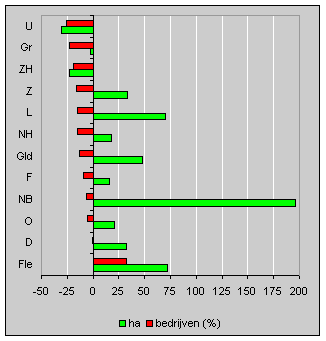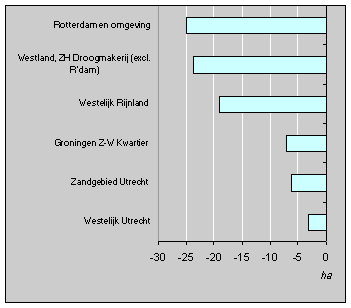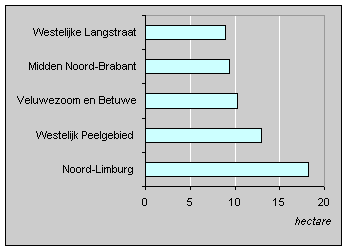Area of glasshouses increases in Brabant, Limburg and Flevoland

The area of glasshouses in the province of South Holland decreased by 23 ha between 1 April 1997 and 1 April 2001. In Utrecht more than 30 ha of glasshouses have been demolished. In nearly all the other provinces the area of glasshouses has increased. The largest increases were in North Brabant (+196 ha), Flevoland (+72 ha) and in Limburg (+70 ha). A small part of horticulture under glass has moved from the west of the country to these growth regions, although more than half of glasshouses are still located in South Holland.
By far most fruit and vegetable growers who cease operations sell their glasshouses to a colleague who wants to expand. This has resulted in large increases in scale. While an average market gardener had glasshouses on 0.8 ha in 1997, by 2001 this area had increased to more than one hectare. This has resulted in a 25 percent increase in the area of glasshouses for an average commercial fruit and vegetable grower in the space of four years.
Horticulture under glass 1997-2001

Shrinking areas
Since 1997 nearly 1,150 fruit and vegetable growers in South Holland have closed down their businesses, the equivalent of one in five. Most of them sold their glasshouses to a colleague, but in some cases the land was used for something other than market gardening. A number of these horticulturists started a new business outside the province.
In the province of Utrecht, too, the number of glasshouses is decreasing, mostly because of the reduction in the area of glasshouses in Vleuten/De Meern, where extensive residential projects are being developed. Between April 2000 and April 2001 dozens of hectares of glasshouses have been removed.
Biggest decreases in areas of glasshouse horticulture, 2000-2001

The traditional glasshouse regions have reached saturation point. Indeed the main reasons fruit and vegetable growers give for leaving the areas in the west of the Netherlands are shortage of space and little room for expansion. At the same time they are confronted by an increasing demand for cut flowers and houseplants. Moreover, the scarcity of suitable locations for residential construction is increasing pressure on the areas where horticulture under glass is practised. This is also the case in the glasshouse areas in western Utrecht.
Biggest increases in areas of glasshouse horticulture, 2000-2001

Growth areas
The government is stimulating the development of new locations for horticulture under glass. This is one of the reasons that a number of horticulturists are looking for opportunities to expand in these areas. In the past year, the area of glasshouses in North Brabant and Limburg in particular have increased substantially. In North Limburg for example 18 ha have been added, and in the western Peel area of North Brabant nearly 13 ha of glasshouses have been constructed. In other parts of North Brabant too, the number of glasshouses is increasing. Other growth areas are located in the north of Zeeland, the west of Overijssel, the Bommelerwaard and in the Noordoostpolder.
Cor Pierik